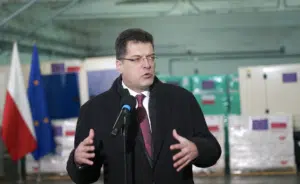Brussels – Nearly 40 rescuers and 16 vehicles will help Germany cope with the floods of recent days, while three more high-capacity modules will arrive to support France. Paris and Berlin asked Brussels to activate the EU Civil Protection Mechanism after heavy rains hit the regions of Bassachsen and Thuringia in Germany and Nord-Pas-de-Calais in France causing floods and river overflows.
In recent days—the European Commission recalls in a note—both countries requested assistance, and the EU quickly provided emergency aid. For Germany, 39 rescuers with flood barriers and 16 vehicles began response activities. For France, three high-capacity modules with four pumps from the Netherlands, two pumps from the Czech Republic, and two pumps from Slovakia are scheduled to depart today.

“As the new year begins, EU solidarity does not waver. Once again, the EU Civil Protection Mechanism’s swift and decisive assistance to the flood-affected regions of Germany and France is a testament to the strength of unity,” commented Crisis Management Commissioner Janez Lenarcic, thanking “Austria, the Czech Republic, France, Hungary, the Netherlands, Slovenia, Slovakia, and Sweden for quickly showing their support.”
How the EU civil protection mechanism works
Created in 2001, the EU Civil Protection Mechanism is the tool by which the 27 member countries and 9 other participating states (Albania, Bosnia and Herzegovina, Iceland, North Macedonia, Montenegro, Norway, Serbia, Turkey, and Ukraine) can strengthen cooperation in preventing, preparing for, and responding to disasters, particularly natural ones. Individual member countries can request its activation when an emergency exceeds their response capabilities. In 21 years of operation, Brussels estimates, the EU Civil Protection Mechanism has responded to over 650 requests for assistance within and outside the Union’s territory.
 The EU Civil Protection Mechanism comprises a European civil protection pool, formed from resources pre-committed by the member states, which can be deployed immediately if needed. The Emergency Response Coordination Center is the operational core and is active every day 24 hours a day. Added to this is the rescEu Reserve, a fleet of firefighting aircraft and helicopters (as well as field hospitals and stockpiles of supplies for medical emergencies) to enhance the components of disaster risk management.
The EU Civil Protection Mechanism comprises a European civil protection pool, formed from resources pre-committed by the member states, which can be deployed immediately if needed. The Emergency Response Coordination Center is the operational core and is active every day 24 hours a day. Added to this is the rescEu Reserve, a fleet of firefighting aircraft and helicopters (as well as field hospitals and stockpiles of supplies for medical emergencies) to enhance the components of disaster risk management.




